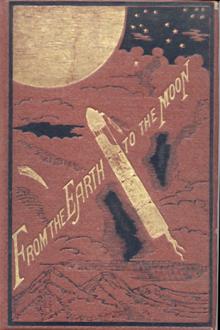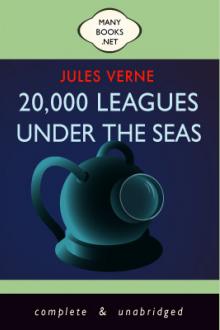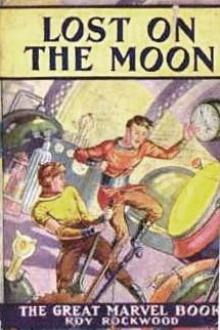From the Earth to the Moon, Jules Verne [online e book reading .TXT] 📗

- Author: Jules Verne
- Performer: -
Book online «From the Earth to the Moon, Jules Verne [online e book reading .TXT] 📗». Author Jules Verne
“You see, old fellow,” he said, “you must not take what I say in bad part; but really, between ourselves, you are in too incomplete a condition to appear in the moon!”
“Incomplete?” shrieked the valiant invalid.
“Yes, my dear fellow! imagine our meeting some of the inhabitants up there! Would you like to give them such a melancholy notion of what goes on down here? to teach them what war is, to inform them that we employ our time chiefly in devouring each other, in smashing arms and legs, and that too on a globe which is capable of supporting a hundred billions of inhabitants, and which actually does contain nearly two hundred millions? Why, my worthy friend, we should have to turn you out of doors!”
“But still, if you arrive there in pieces, you will be as incomplete as I am.”
“Unquestionably,” replied Michel Ardan; “but we shall not.”
In fact, a preparatory experiment, tried on the 18th of October, had yielded the best results and caused the most well-grounded hopes of success. Barbicane, desirous of obtaining some notion of the effect of the shock at the moment of the projectile’s departure, had procured a 38-inch mortar from the arsenal of Pensacola. He had this placed on the bank of Hillisborough Roads, in order that the shell might fall back into the sea, and the shock be thereby destroyed. His object was to ascertain the extent of the shock of departure, and not that of the return.
A hollow projectile had been prepared for this curious experiment. A thick padding fastened upon a kind of elastic network, made of the best steel, lined the inside of the walls. It was a veritable nest most carefully wadded.
“What a pity I can’t find room in there,” said J. T. Maston, regretting that his height did not allow of his trying the adventure.
Within this shell were shut up a large cat, and a squirrel belonging to J. T. Maston, and of which he was particularly fond. They were desirous, however, of ascertaining how this little animal, least of all others subject to giddiness, would endure this experimental voyage.
The mortar was charged with 160 pounds of powder, and the shell placed in the chamber. On being fired, the projectile rose with great velocity, described a majestic parabola, attained a height of about a thousand feet, and with a graceful curve descended in the midst of the vessels that lay there at anchor.
Without a moment’s loss of time a small boat put off in the direction of its fall; some divers plunged into the water and attached ropes to the handles of the shell, which was quickly dragged on board. Five minutes did not elapse between the moment of enclosing the animals and that of unscrewing the coverlid of their prison.
Ardan, Barbicane, Maston, and Nicholl were present on board the boat, and assisted at the operation with an interest which may readily be comprehended. Hardly had the shell been opened when the cat leaped out, slightly bruised, but full of life, and exhibiting no signs whatever of having made an aerial expedition. No trace, however, of the squirrel could be discovered. The truth at last became apparent— the cat had eaten its fellow-traveler!
J. T. Maston grieved much for the loss of his poor squirrel, and proposed to add its case to that of other martyrs to science.
After this experiment all hesitation, all fear disappeared. Besides, Barbicane’s plans would ensure greater perfection for his projectile, and go far to annihilate altogether the effects of the shock. Nothing now remained but to go!
Two days later Michel Ardan received a message from the President of the United States, an honor of which he showed himself especially sensible.
After the example of his illustrious fellow-countryman, the Marquis de la Fayette, the government had decreed to him the title of “Citizen of the United States of America.”
THE PROJECTILE-VEHICLE
On the completion of the Columbiad the public interest centered in the projectile itself, the vehicle which was destined to carry the three hardy adventurers into space.
The new plans had been sent to Breadwill and Co., of Albany, with the request for their speedy execution. The projectile was consequently cast on the 2nd of November, and immediately forwarded by the Eastern Railway to Stones Hill, which it reached without accident on the 10th of that month, where Michel Ardan, Barbicane, and Nicholl were waiting impatiently for it.
The projectile had now to be filled to the depth of three feet with a bed of water, intended to support a water-tight wooden disc, which worked easily within the walls of the projectile. It was upon this kind of raft that the travelers were to take their place. This body of water was divided by horizontal partitions, which the shock of the departure would have to break in succession. Then each sheet of the water, from the lowest to the highest, running off into escape tubes toward the top of the projectile, constituted a kind of spring; and the wooden disc, supplied with extremely powerful plugs, could not strike the lowest plate except after breaking successively the different partitions. Undoubtedly the travelers would still have to encounter a violent recoil after the complete escapement of the water; but the first shock would be almost entirely destroyed by this powerful spring. The upper parts of the walls were lined with a thick padding of leather, fastened upon springs of the best steel, behind which the escape tubes were completely concealed; thus all imaginable precautions had been taken for averting the first shock; and if they did get crushed, they must, as Michel Ardan said, be made of very bad materials.
The entrance into this metallic tower was by a narrow aperture contrived in the wall of the cone. This was hermetically closed by a plate of aluminum, fastened internally by powerful screw-pressure. The travelers could therefore quit their prison at pleasure, as soon as they should reach the moon.
Light and view were given by means of four thick lenticular glass scuttles, two pierced in the circular wall itself, the third in the bottom, the fourth in the top. These scuttles then were protected against the shock of departure by plates let into solid grooves, which could easily be opened outward by unscrewing them from the inside. Reservoirs firmly fixed contained water and the necessary provisions; and fire and light were procurable by means of gas, contained in a special reservoir under a pressure of several atmospheres. They had only to turn a tap, and for six hours the gas would light and warm this comfortable vehicle.
There now remained only the question of air; for allowing for the consumption of air by Barbicane, his two companions, and two dogs which he proposed taking with him, it was necessary to renew the air of the projectile. Now air consists principally of twenty-one parts of oxygen and seventy-nine of nitrogen. The lungs absorb the oxygen, which is indispensable for the support of life, and reject the nitrogen. The air expired loses nearly five per cent. of the former and contains nearly an equal volume of carbonic acid, produced by the combustion of the elements of the blood. In an air-tight enclosure, then, after a certain time, all the oxygen of the air will be replaced by the carbonic acid— a gas fatal to life. There were two things to be done then— first, to replace the absorbed oxygen; secondly, to destroy the expired carbonic acid; both easy enough to do, by means of chlorate of potassium and caustic potash. The former is a salt which appears under the form of white crystals; when raised to a temperature of 400 degrees it is transformed into chlorure of potassium, and the oxygen which it contains is entirely liberated. Now twenty-eight pounds of chlorate of potassium produces seven pounds of oxygen, or 2,400 litres— the quantity necessary for the travelers during twenty-four hours.
Caustic potash has a great affinity for carbonic acid; and it is sufficient to shake it in order for it to seize upon the acid and form bicarbonate of potassium. By these two means they would be enabled to restore to the vitiated air its life-supporting properties.
It is necessary, however, to add that the experiments had hitherto been made in anima vili. Whatever its scientific accuracy was, they were at present ignorant how it would answer with human beings. The honor of putting it to the proof was energetically claimed by J. T. Maston.
“Since I am not to go,” said the brave artillerist, “I may at least live for a week in the projectile.”
It would have been hard to refuse him; so they consented to his wish. A sufficient quantity of chlorate of potassium and of caustic potash was placed at his disposal, together with provisions for eight days. And having shaken hands with his friends, on the 12th of November, at six o’clock A.M., after strictly informing them not to open his prison before the 20th, at six o’clock P.M., he slid down the projectile, the plate of which was at once hermetically sealed. What did he do with himself during that week? They could get no information. The thickness of the walls of the projectile prevented any sound reaching from the inside to the outside. On the 20th of November, at six P.M. exactly, the plate was opened. The friends of J. T. Maston had been all along in a state of much anxiety; but they were promptly reassured on hearing a jolly voice shouting a boisterous hurrah.
Presently afterward the secretary of the Gun Club appeared at the top of the cone in a triumphant attitude. He had grown fat!
THE TELESCOPE OF THE ROCKY MOUNTAINS
On the 20th of October in the preceding year, after the close of the subscription, the president of the Gun Club had credited the Observatory of Cambridge with the necessary sums for the construction of a gigantic optical instrument. This instrument was designed for the purpose of rendering visible on the surface of the moon any object exceeding nine feet in diameter.
At the period when the Gun Club essayed their great experiment, such instruments had reached a high degree of perfection, and produced some magnificent results. Two telescopes in particular, at this time, were possessed of remarkable power and of gigantic dimensions. The first, constructed by Herschel, was thirty-six feet in length, and had an object-glass of four feet six inches; it possessed a magnifying power of 6,000. The second was raised in Ireland, in Parsonstown Park, and belongs to Lord Rosse. The length of this tube is forty-eight feet, and the diameter of its object-glass six feet; it magnifies 6,400 times, and required an immense erection of brick work and masonry for the purpose of working it, its weight being twelve and a half tons.
Still, despite these colossal dimensions, the actual enlargements scarcely exceeded 6,000 times in round numbers; consequently, the moon was brought within no nearer an apparent distance than thirty-nine miles; and objects of less than sixty feet in diameter, unless they were of very considerable length, were still imperceptible.
In the present case, dealing with a projectile nine feet in diameter and fifteen feet long, it became necessary to bring the moon within an apparent distance of five miles at most; and for that purpose to establish a magnifying power of 48,000 times.
Such was the question proposed to the Observatory of Cambridge, There was no lack of funds; the difficulty was purely one of construction.
After considerable discussion as to the best form and principle of the proposed instrument the work was finally commenced. According to the calculations of





Comments (0)